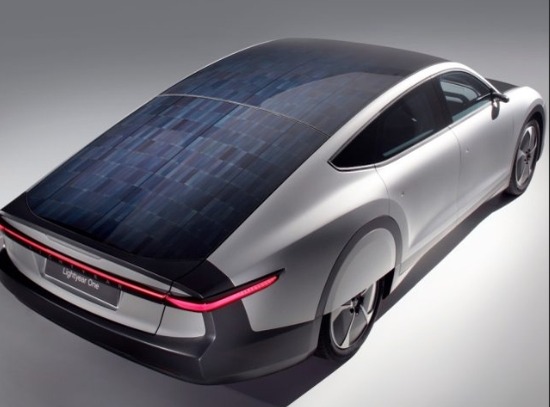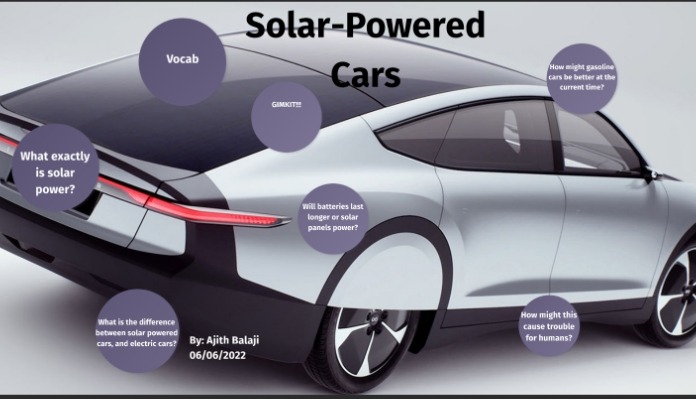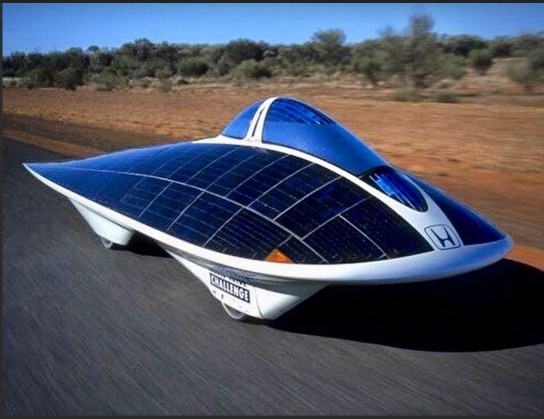Introduction
5 Powerful Ways Solar-Powered Cars: The global automotive sector is undergoing a transformative shift as it embraces renewable energy to address the urgent need for sustainable solutions. With the growing emphasis on reducing greenhouse gas emissions and decreasing dependency on fossil fuels, renewable energy sources are becoming integral to the future of mobility. Among these advancements, solar-powered cars stand out as a revolutionary innovation, merging environmental stewardship with cutting-edge technology.
5 Powerful Ways Solar-Powered Cars represent a remarkable leap forward, leveraging the sun’s abundant energy to drive efficiency, independence, and sustainability. By incorporating photovoltaic panels and energy storage systems, these vehicles are setting new benchmarks for eco-friendly transportation. Beyond reducing carbon footprints, they offer the promise of cleaner air, lower energy costs, and a brighter future for both drivers and the planet.
In this blog, we will explore seven unique ways 5 Powerful Ways Solar-Powered Cars are shaping the automotive industry. From their environmental benefits to the challenges they face, this innovation is paving the way for a greener, smarter, and more sustainable approach to mobility. Join us as we delve into the impact and potential of solar-powered vehicles to revolutionize transportation and redefine the industry’s role in environmental preservation.
1. Solar Technology in Car Design

5 Powerful Ways Solar-Powered Cars technology in car design is a revolutionary innovation that taps into the limitless energy of the sun to power vehicles. By integrating solar panels and advanced energy systems, automakers are pushing the boundaries of efficiency, sustainability, and mobility. Here’s how this cutting-edge technology is shaping the future of automotive design:
Integration of Solar Panels: Overview of How Photovoltaic Cells Are Incorporated into Vehicles
- Roof and Body Panels: Solar-powered cars are designed with photovoltaic (PV) cells embedded into their roofs and sometimes the body panels. These cells capture sunlight and convert it into electrical energy.
- Flexible Solar Films: Advances in material science have enabled the use of lightweight and flexible solar films that conform to curved car surfaces, maximizing energy capture without adding significant weight.
- Aesthetic Design: Solar panel integration is increasingly streamlined, ensuring vehicles maintain a sleek and modern aesthetic while incorporating functional energy systems.
- Dynamic Energy Capture: Panels are engineered to operate efficiently even in low light conditions or when the car is in motion, ensuring consistent energy generation.
Energy Storage: Role of Advanced Battery Systems in Optimizing Solar Energy Utilization
- High-Capacity Batteries: 5 Powerful Ways Solar-Powered Cars-powered vehicles use high-capacity lithium-ion or solid-state batteries to store the energy generated from sunlight, enabling continuous operation even when sunlight is unavailable.
- Energy Management Systems: Smart energy management technologies optimize the flow of solar energy, balancing power distribution between vehicle components and storage systems.
- Hybrid Integration: Many solar-powered vehicles integrate with existing electric vehicle (EV) systems, using solar energy as a supplementary source to extend driving range and reduce reliance on charging stations.
- On-Demand Power Supply: Efficient energy storage ensures vehicles can deliver consistent performance, whether they are parked in the sun or navigating shaded areas.
Future Enhancements: Cutting-Edge Research in Solar Panel Efficiency for Cars
- Next-Generation PV Cells: Research into multi-junction solar cells is showing promise, with the potential to significantly increase energy conversion efficiency compared to traditional silicon-based cells.
- Transparent Solar Panels: Innovations in transparent PV technology could allow for windows and windshields to generate additional energy without obstructing visibility.
- Self-Healing Panels: Researchers are exploring materials capable of repairing minor damage to PV cells, ensuring longer lifespans and better performance over time.
- Improved Durability: Development of impact-resistant and weatherproof solar panels ensures they remain functional in various environmental conditions, making solar-powered cars more practical for everyday use.
By seamlessly integrating photovoltaic technology, solar-powered cars exemplify the potential of renewable energy to transform automotive design. These innovations are paving the way for a cleaner, greener future, with vehicles that not only reduce dependence on fossil fuels but also demonstrate the power of sustainable engineering.
Click Here: Forget Public Charging! Power Your Electric Car with the SUN | GoSu
2. Benefits of Solar-Powered Cars for Drivers

Solar-powered cars offer a host of benefits for drivers, combining environmental consciousness with practicality and efficiency. By harnessing renewable energy, these vehicles redefine the driving experience, making it more sustainable and convenient for modern lifestyles. Here’s how solar-powered cars empower drivers in unique and impactful ways:
Energy Independence: Reducing Reliance on Traditional Power Grids or Fossil Fuels
- Self-Sufficient Energy Source: Solar-powered cars capture and store energy directly from the sun, reducing the need for electricity from the grid or fuel from gas stations.
- Renewable Mobility: Drivers gain independence from fluctuating energy prices and limited fossil fuel supplies, making solar-powered cars a reliable and long-term solution.
- Remote Accessibility: Solar charging allows these cars to operate even in areas with limited charging infrastructure, providing autonomy for long-distance travel or rural driving.
Cost Savings: Long-Term Financial Advantages from Lower Fuel and Electricity Expenses
- Free Energy from the Sun: By utilizing solar energy, drivers save significantly on fuel costs and reduce expenses associated with electricity charging for traditional EVs.
- Maintenance Efficiency: Solar panels are designed with durability in mind, minimizing the need for costly repairs or replacements.
- Total Cost of Ownership: Over time, drivers can benefit from substantial savings due to reduced operating costs, which make solar-powered cars an economical investment despite the initial purchase price.
Convenience: On-the-Go Solar Charging for Increased Travel Flexibility
- Continuous Energy Generation: Solar-powered cars can charge their batteries while parked or even driving, ensuring energy availability throughout the day.
- Flexibility for Long Trips: Drivers enjoy the ability to travel longer distances without worrying about finding charging stations, especially in sunny regions.
- Reduced Downtime: On-the-go charging reduces wait times associated with traditional charging methods, offering greater convenience and efficiency for busy schedules.
Solar-powered cars revolutionize driving by offering independence, affordability, and unmatched convenience. These benefits not only enhance the driving experience but also inspire a shift toward sustainable practices that align with the growing demand for eco-conscious mobility solutions.
यह भी पढ़े: “10 Groundbreaking and Revolutionary Car Innovations Driving Sustainable and Smarter Mobility”
3. Environmental Contributions of Solar-Powered Cars

Solar-powered cars offer profound environmental benefits, redefining the automotive industry as a key player in sustainability. By prioritizing renewable energy and minimizing ecological harm, these vehicles contribute to global efforts aimed at preserving the planet for future generations.
Zero Emissions: Lower Greenhouse Gas Output Compared to Conventional Cars
- Zero Pollutant Emissions: Unlike gasoline-powered cars, solar-powered vehicles emit no harmful gases, such as carbon dioxide or nitrogen oxides, during operation.
- Cleaner Air Quality: Their eco-friendly design reduces air pollution in urban areas, leading to healthier living conditions for communities worldwide.
- Long-Term Benefits: Widespread adoption of zero-emission vehicles can significantly mitigate climate change by reducing the automotive sector’s carbon footprint.
Carbon Footprint Reduction: Long-Term Impact on Global Environmental Conservation
- Sustainable Energy Source: Solar-powered cars rely on the sun’s renewable energy, minimizing dependency on finite fossil fuels and reducing overall environmental degradation.
- Reduced Lifecycle Impact: By combining clean energy usage with advanced manufacturing processes, solar-powered vehicles generate a lower carbon footprint throughout their lifecycle.
- Global Impact: As more individuals transition to solar-powered mobility, collective carbon savings contribute to worldwide environmental preservation efforts.
Promotion of Renewable Energy Awareness: Driving Demand for Cleaner Energy Sources
- Showcasing Solar Potential: 5 Powerful Ways Solar-Powered Cars highlight the viability of harnessing the sun’s energy for everyday purposes, inspiring wider adoption of renewable solutions.
- Driving Industry Innovation: Automakers investing in solar technology set a precedent for incorporating renewable energy across industries.
- Building Consumer Awareness: 5 Powerful Ways Solar-Powered Cars vehicles encourage individuals to choose sustainable transportation options, fostering eco-conscious habits and promoting renewable energy advocacy.
Through zero emissions, reduced carbon footprints, and the promotion of renewable energy awareness, 5 Powerful Ways Solar-Powered Cars are revolutionizing environmental conservation within the automotive sector. Their contributions extend beyond transportation, serving as symbols of sustainability and inspiring global progress toward a cleaner, greener future.
4. Challenges and Limitations

While 5 Powerful Ways Solar-Powered Cars offer groundbreaking potential, there are significant challenges and limitations that must be addressed to make this technology more accessible and efficient. These include technological barriers, economic factors, and the need for supportive infrastructure, all of which shape the growth trajectory of solar-powered mobility.
Efficiency Concerns: Current Technological Barriers in Solar Energy Capture and Conversion
- Limited Conversion Efficiency: Current 5 Powerful Ways Solar-Powered Cars used in cars typically achieve an energy conversion rate of about 20–25%, which may not generate sufficient power for long-range or high-speed driving.
- Dependency on Weather: 5 Powerful Ways Solar-Powered Cars rely heavily on direct sunlight, making them less effective in regions with limited sunlight or during cloudy and rainy conditions.
- Energy Storage Constraints: Although battery technology is advancing, storing sufficient solar energy for consistent performance remains a challenge, especially for vehicles designed for long-distance travel.
- Surface Area Limitations: The size of a car’s body limits the number of 5 Powerful Ways Solar-Powered Cars that can be integrated, placing constraints on how much energy can be captured.
- Cost of Implementation: High Initial Investment for Manufacturers and Consumers
- Expensive Materials: The development of efficient photovoltaic panels and lightweight materials significantly increases production costs for manufacturers.
- Research and Development Costs: High expenditures on R&D for improving solar technology and integrating it with automotive systems make solar-powered cars less economically viable in the short term.
- Premium Pricing: Due to high manufacturing costs, the retail price of 5 Powerful Ways Solar-Powered Cars vehicles remains out of reach for many consumers, limiting widespread adoption.
- Cost Recovery Timeline: While operational costs are lower, the initial investment in solar-powered cars can take years to recoup, potentially discouraging budget-conscious buyers.
Infrastructure Development: Need for Supportive Policies and Solar Charging Networks
- Lack of Infrastructure: The absence of widespread 5 Powerful Ways Solar-Powered Cars charging stations makes it challenging to fully rely on solar energy for long-distance or remote travel.
- Policy and Incentives: Governments must introduce supportive policies, including tax incentives or subsidies, to make 5 Powerful Ways Solar-Powered Cars and charging infrastructure more attractive to manufacturers and consumers.
- Global Variability: Infrastructure development is uneven across regions, with some areas lagging in renewable energy adoption, thereby slowing the progress of solar-powered mobility.
- Integration with Grid Systems: Creating a seamless network where 5 Powerful Ways Solar-Powered Cars-powered vehicles can both charge from and contribute energy to the grid requires advanced technologies and significant investments.
Despite these challenges, continued investment in research and development, supportive government policies, and advances in infrastructure could overcome these limitations. Addressing these hurdles is key to unlocking the full potential of 5 Powerful Ways Solar-Powered Cars and propelling the automotive industry toward a sustainable future.
5. Innovations Driving Solar-Powered Cars

The development of 5 Powerful Ways Solar-Powered Cars is being fueled by groundbreaking innovations in technology, design, and engineering. From hybrid systems to AI integration, these advancements are unlocking the full potential of solar energy, making it a viable and efficient solution for modern mobility.
- Hybrid Systems: Combining Solar Energy with Electric or Hydrogen Fuel Technologies
- Dual Energy Sources: Hybrid solar-powered cars combine solar energy with battery-electric or hydrogen fuel cell systems, enabling greater energy efficiency and flexibility.
- Extended Range: 5 Powerful Ways Solar-Powered Cars provide additional power to supplement the main energy source, whether it’s an EV battery or hydrogen fuel cell, resulting in longer driving ranges.
- Energy Optimization: Hybrid systems balance the use of solar energy with other renewable sources, ensuring consistent performance in varying weather conditions.
- Real-World Applications: These systems are particularly effective in reducing dependency on grid charging or hydrogen refueling, making cars more sustainable and adaptable for diverse environments.
AI Integration: Using Artificial Intelligence to Optimize Solar Energy Utilization
- Smart Energy Management: AI algorithms analyze energy generation, storage, and consumption patterns to optimize solar power usage, ensuring maximum efficiency.
- Dynamic Energy Allocation: AI systems prioritize energy distribution, directing power to essential components such as the motor, climate control, or auxiliary systems as needed.
- Predictive Maintenance: AI monitors the condition of 5 Powerful Ways Solar-Powered Cars and battery systems, identifying potential issues before they affect performance, which increases the lifespan of the vehicle.
- Route Optimization: Leveraging AI, 5 Powerful Ways Solar-Powered Cars can suggest routes with optimal sunlight exposure, further enhancing energy generation during trips.
Material Advancements: Innovations in Lightweight, Efficient Solar Panels
- Flexible Solar Films: New lightweight materials allow 5 Powerful Ways Solar-Powered Cars to conform to the shape of the car’s body, maximizing surface area for energy capture without adding significant weight.
- High-Efficiency Photovoltaics: Advances in photovoltaic cell technology, including multi-junction and perovskite solar cells, are increasing energy conversion rates significantly.
- Durability and Longevity: Modern panels are designed to withstand extreme weather conditions and minor impacts, ensuring reliable performance over the vehicle’s lifetime.
- Transparent Solar Panels: Innovations in transparent photovoltaics are enabling windows and sunroofs to generate additional energy, further enhancing the efficiency of solar-powered cars.
These innovations are not only advancing the capabilities of 5 Powerful Ways Solar-Powered Cars but also showcasing the potential of renewable energy to transform the automotive industry. By combining cutting-edge technologies and sustainable practices, automakers are driving the future of mobility toward cleaner, smarter, and more efficient solutions.
6. Role of Solar-Powered Cars in the Automotive Industry

5 Powerful Ways Solar-Powered Cars are gaining traction in the automotive sector as an innovative solution for sustainable transportation. Their development and integration are influencing the industry in remarkable ways, from pioneering advancements to reshaping consumer markets and future design trends.
Industry Leadership: Companies Pioneering the Development of Solar-Powered Cars
Trailblazing Automakers: Several companies are taking the lead in designing and manufacturing solar-powered vehicles. Innovators like Lightyear, with its solar-powered EVs, and Sono Motors, known for the Sion solar car, are pushing the boundaries of renewable energy applications.
- Collaborations for Innovation: Partnerships between automakers, 5 Powerful Ways Solar-Powered Cars providers, and research institutions are accelerating the development of highly efficient solar-powered vehicles.
- Setting New Standards: These leaders are establishing benchmarks for incorporating solar energy into cars, inspiring competitors to adopt sustainable technologies.
- Market Growth: Increasing Consumer Interest in Sustainable Vehicles
- Demand for Sustainability: As global environmental awareness grows, consumers are actively seeking green alternatives like solar-powered cars to reduce their ecological footprint.
- Expanding Market Opportunities: Solar-powered cars are opening up new market segments, particularly in regions with abundant sunlight where renewable energy solutions align with local needs.
- Cost Efficiency Appeal: The long-term savings from reduced fuel or electricity consumption make these vehicles an attractive choice for eco-conscious consumers.
- Government Support: Policies such as tax incentives and subsidies for sustainable vehicles are encouraging adoption and stimulating market growth.
Shaping the Future: How Solar Cars Influence Automotive Design and Manufacturing
Design Revolution: Solar-powered cars require unique designs, incorporating photovoltaic panels seamlessly into the body while balancing aesthetics and functionality.
- Manufacturing Adaptation: The rise of solar vehicles is prompting manufacturers to adopt sustainable practices, including the use of recycled materials and energy-efficient production processes.
- Integration with Smart Systems: Solar-powered cars are fostering advancements in connected technologies, integrating AI and IoT to optimize solar energy usage and enhance vehicle performance.
- Inspiring Broader Innovations: These vehicles are serving as a catalyst for the development of other renewable energy-driven innovations within the automotive industry.
Solar-powered cars are not just vehicles—they’re a driving force behind the industry’s shift toward sustainability and smart mobility. By leading innovation, appealing to the eco-conscious market, and influencing future design and manufacturing practices, they are reshaping the landscape of the automotive sector and contributing to a greener, more sustainable future.
7. Call-to-Action: Embracing Solar-Powered Cars
5 Powerful Ways Solar-Powered Cars are not just an innovation—they are a step toward a sustainable and eco-friendly future. Now is the time to embrace these transformative vehicles and take actionable steps that contribute to cleaner transportation and renewable energy adoption.
Adopt the Trend: Explore Solar-Powered Car Options for Sustainable Driving
- Discover Your Choices: Take the time to explore available solar-powered car models, from hybrid designs to fully solar-integrated vehicles, that align with your needs and lifestyle.
- Test the Benefits: Experience the advantages firsthand, such as reduced energy costs, environmental impact, and unique features like solar charging capabilities.
- Join the Movement: By choosing solar-powered cars, you actively participate in the transition to cleaner, greener mobility, inspiring others to follow suit.
Support Renewable Energy: Promote Awareness and Investment in Solar Technologies
- Educate Yourself and Others: Spread awareness about the environmental and financial benefits of solar-powered vehicles and how they contribute to a sustainable future.
- Invest in Solar Solutions: Support companies and initiatives that innovate in solar technology, such as research for efficient photovoltaic systems or expanding solar charging infrastructure.
- Advocate for Renewable Practices: Become an advocate for renewable energy across industries, emphasizing its importance for environmental conservation and long-term growth.
Drive Change: Inspire Advocacy for Policies That Advance Renewable Energy Adoption
- Push for Incentives: Support policies that provide tax benefits, subsidies, or funding for 5 Powerful Ways Solar-Powered Cars manufacturers and buyers.
- Encourage Infrastructure Growth: Advocate for the development of solar charging networks, making renewable energy accessible to drivers everywhere.
- Be the Voice for Sustainability: Share your experiences and ideas to inspire governmental and industry leaders to prioritize solar energy in transportation.
Embracing 5 Powerful Ways Solar-Powered Cars is more than a lifestyle choice—it’s a commitment to a sustainable planet. By adopting this trend, supporting renewable energy initiatives, and advocating for forward-thinking policies, we can drive meaningful change and build a future where transportation 5 Powerful Ways Solar-Powered Cars aligns harmoniously with environmental preservation. Let’s make the leap together toward cleaner roads and a greener tomorrow.

